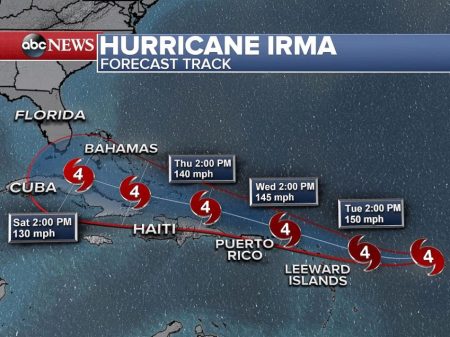(Reuters) – Hurricane Irma, barreling towards the Caribbean and the southern United States, was upgraded to a powerful Category 4 storm yesterday as islands in its path braced themselves.
Hurricane advisories were issued for territories that dot the West Indies, including parts of the Leeward Islands, the British and U.S. Virgin Islands and Puerto Rico in preparation for the intensifying storm that could pummel the area with life-threatening wind, storm surges and torrential rain by Tuesday evening, according to the U.S. National Hurricane Center (NHC).
 A Category 4 hurricane on the five-step Saffir-Simpson scale means sustained winds of 130-156 miles per hour (209-251 kph) with “catastrophic” outcomes, including uprooted trees and downed power lines, water and electricity outages, and significant property damage causing uninhabitable conditions, according to the Miami-based hurricane center.
A Category 4 hurricane on the five-step Saffir-Simpson scale means sustained winds of 130-156 miles per hour (209-251 kph) with “catastrophic” outcomes, including uprooted trees and downed power lines, water and electricity outages, and significant property damage causing uninhabitable conditions, according to the Miami-based hurricane center.
Irma, now packing 130 mph (215 kph) winds, also threatens the U.S. East Coast and Florida, which on Monday evening declared a state of emergency. The hurricane center expects Irma to reach southern Florida on Saturday.
The NHC cautioned that it was still too early to forecast the storm’s exact path or what effects it might have on the continental United States, but warned of likely effects to hit some areas by later this week.
“There is an increasing chance of seeing some impacts from Irma in the Florida Peninsula and the Florida Keys later this week and this weekend. In addition, rough surf and dangerous marine conditions will begin to affect the southeastern U.S. coast by later this week,” the center said.
Irma will be the second powerful hurricane to thrash the United States and its territories in as many weeks.
Residents in Texas and Louisiana are still reeling from the catastrophic effects of the deadly Hurricane Harvey, which struck Texas as a Category 4 hurricane on Aug. 25 and dumped several feet (meters) of rain, destroying thousands of homes and businesses.
Irma is forecast to strengthen over the next 48 hours and could “directly affect Hispaniola, the Turks and Caicos, the Bahamas, and Cuba as a dangerous major hurricane later this week,” the NHC said.
In preparation for the storm, the economically struggling Puerto Rico government on Monday declared a state of emergency and activated the National Guard.
“Despite the economic challenges Puerto Rico is facing, the approved budget has $15 million for the emergency fund,” Governor Ricardo Rosselló said in a statement. The island of about 3.4 million people has 456 emergency shelters prepared to house up to 62,100 people.
To help residents prepare for the storm, the Puerto Rican government activated a price freeze on basic necessities, including food and water, medicines, power generators and batteries.
Telemundo TV station WIPR in Puerto Rico showed long lines of shoppers stocking up on bottled water, flashlights, batteries, generators, food and other items.
The executive director of the state power authority, Ricardo Ramos, told the station that the power grid was so vulnerable from lack of investment that parts of the U.S. territory could be without power for three to four months.
“We’re preparing for the worst-case scenario,” he said.





